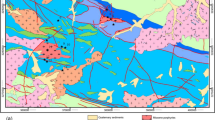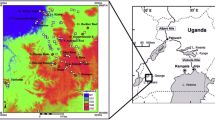Abstract
Procedures are discussed to construct target maps ranking the likelihood of future discoveries: for instance, of gold occurrences, knowing location and spatial context, of a set of genetically related gold vein deposits. A favorability modeling process is iterated with a subset of the known occurrences, i.e., the locations of the deposits. The resulting prediction patterns are cross-validated with the distribution of the left-out occurrences, considered as representing the future discoveries. The target map originates from integration of all prediction patterns from the iterations. Rank-based statistics related to the target maps provides measures of quality, robustness and uncertainty of the classification of a study area into likelihood of discovery. Much of this is a relatively new area of research, so that to interpret such uncertainty is still a challenge. Four critical questions are formulated that identify areas in need of extensive research for any modeling procedure. They relate to the quality of prediction patterns, their associated uncertainty of class membership, their sensitivity to redundancy and to congruity within the database. A spatial database developed for advanced training is used to generate target maps. It comes from a study in the Red Lake area in northern Ontario, Canada. It contains information on 37 gold vein deposits. Their neighborhood distribution is instrumental to establishing spatial relationships with the units of categorical thematic maps and continuous field maps. The experimental results point at the extraction of significant properties of the spatial data that cannot be ignored but that we have yet to master to substantiate the reliability of prediction patterns.













Similar content being viewed by others
References
Chung, C. F. (1978). Computer program for the logistic model to estimate the probability of occurrence of discrete events. Geological Survey of Canada, GSC paper 78–11 (pp. 1–23).
Chung, C. F. (2003). Use of airborne geophysical surveys for constructing mineral potential map. In W. D. Goodfellow, S. R. McCutcheon, & M. Peter Jan (Eds.), Massive sulfide deposits of the bathurst mining camp, and northern Maine (pp. 879–891). Economic Geology Monograph 11, Society of Economic Geology Inc., Littleton, CO.
Chung, C. F. (2006). Using likelihood ratio functions for modeling the conditional probability of occurrence of future landslides for risk assessment. Computers & Geosciences,32, 1052–1068.
Chung, C. F., & Fabbri, A. G. (1993). The representation of geoscience information for data integration. Nonrenewable Resources,2, 122–139.
Chung, C. F., & Fabbri, A. G. (2003). Validation of spatial prediction models for landslide hazard mapping. Natural Hazards,30, 451–472.
Chung, C.-J., & Fabbri, A. G. (2004). Systematic procedures of landslide hazard mapping for risk assessment using spatial prediction models. In T. Glade, M. G. Anderson, & M. J. Crozier (Eds.), Landslide hazard and risk (pp. 139–174). New York, NY: Wiley.
Chung, C.-J., & Fabbri, A. G. (2008). Modular course in quantitative methods for mineral exploration, Department of Earth Sciences, University of Ottawa, Canada, 16–23 February, 2008 (pp. 1–52). Unpublished manuscript.
Chung, C.-J., & Fabbri, A. G. (2013). Modeling target maps of future gold occurrences with combination of categorical and continuous conditionally-dependent supporting patterns. In Proceedings of 12th SGA biennial meeting, 2 (pp. 476–479), Uppsala, Sweden, August 12–15.
Chung, C. F., Fabbri, A. G., & Chi, K. H. (2003). A strategy for sustainable development of nonrenewable resources using spatial prediction models. In A. G. Fabbri, G. Gáal, & R. B. McCammon (Eds.), Geoenvironmental deposit models for resource exploitation and environmental security (pp. 101–118). Dordrecht: NATO ASI Volume, Kluwer.
Davis, J. C., Chung, C. F., & Ohlmacher, G. C. (2006). Two models for evaluating landslide hazards. Computers & Geosciences,32, 1120–1127.
Fabbri, A. G., & Chung, C.-J. (2008). On blind tests and spatial prediction models. Natural Resources Research,17, 107–118.
Fabbri, A. G., & Chung, C.-J. (2012). A spatial prediction modeling system for mineral potential and natural hazard mapping. In Proceedings of EUREGEO2012, II (pp. 756–757), Bologna, Italy, June 12–15, 2012.
Fabbri, A. G., Patera, A., & Chung, C.-J. (2017). Spatial target mapping: An approach to susceptibility prediction based on iterative cross-validations. In E. Alonso, J. Corominas & H. Hürlimann (Eds.), Proceedings of IX Simposio Nacional sobre Taludes y Laderas Instables (pp. 468–479). Santander Spain 27–30, June 2017, Barcelona, Centre Internacional de Mètodes Numèrics en Enginyeria (CIMNE).
Fabbri, A. G., Poli, S., Patera, A., Cavallin, A., & Chung, C.-J. (2014). Estimation of information loss when masking conditional dependence and categorizing continuous data. Further experiments on a database for spatial prediction modeling in Northern Italy. In E. Pardo-Igúzquiza, C. Guardiola-Albert, J. Heredia, L. Moreno-Merino, J. J. Duran & J. A. Vargas-Guzmán (Eds.), Mathematics of planet earth, proceedings of the 15th annual conference of the international association for mathematical geosciences (pp. 291–294). Madrid, 2–6 September 2013. Berlin: Springer.
GSC 2000. Panagapko, D. A. (2000). Preliminary release of geoscience data Red Lake greenstone belt, northwestern Ontario, Geological Survey of Canada Open File 3751.
Hillary, B., Kerswill, J., Keating, P., Harris, J., & Chung, C.-J. (2008). Description and illustration of data used in the Red Lake case study. In Modular Course in Quantitative Methods for Mineral Exploration, Department of Earth Sciences, University of Ottawa, Canada, 16–23 February, 2008 (pp. 1–28). Unpublished manuscript.
Reichenbach, P., Rossi, M., Malamud, B. D., Mihir, M., & Guzzetti, F. (2018). A review of statistically based landslide susceptibility models. Earth Sciences Reviews,180, 60–91.
Schaeben, H. (2014). Potential modeling: Conditional dependence matter. GEM – International Journal of Geomathematics,5, 99–116.
Vakhshoori, V., & Zare, M. (2018). Is the ROC curve a reliable tool to compare the validity of landslide susceptibility maps? Geomatics, Natural Hazards and Risks,9, 249–266.
Author information
Authors and Affiliations
Corresponding author
Rights and permissions
About this article
Cite this article
Chung, CJ., Fabbri, A.G. Mineral Occurrence Target Mapping: A General Iterative Strategy in Prediction Modeling for Mineral Exploration. Nat Resour Res 29, 115–134 (2020). https://doi.org/10.1007/s11053-019-09494-5
Received:
Accepted:
Published:
Issue Date:
DOI: https://doi.org/10.1007/s11053-019-09494-5




